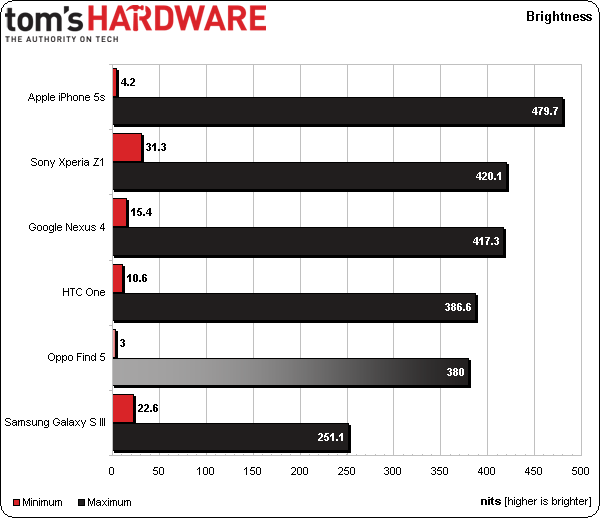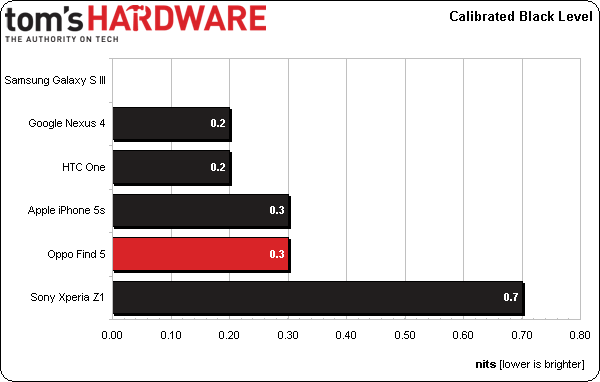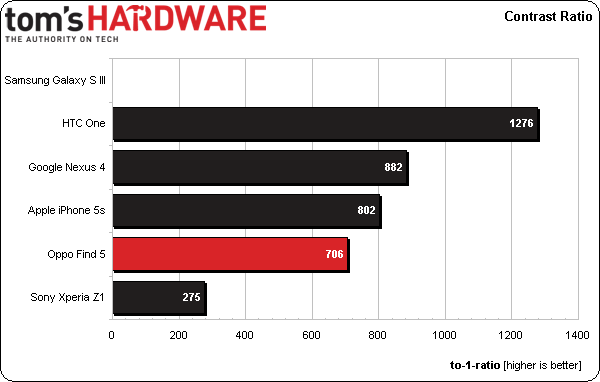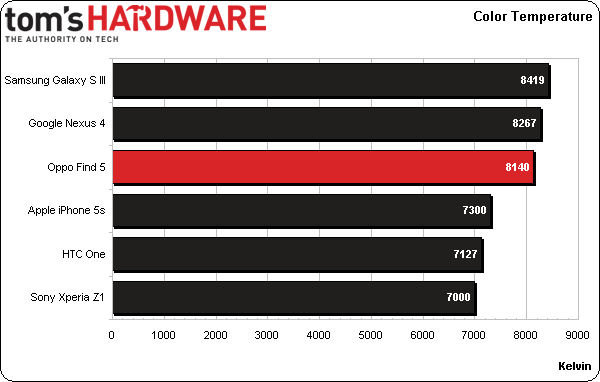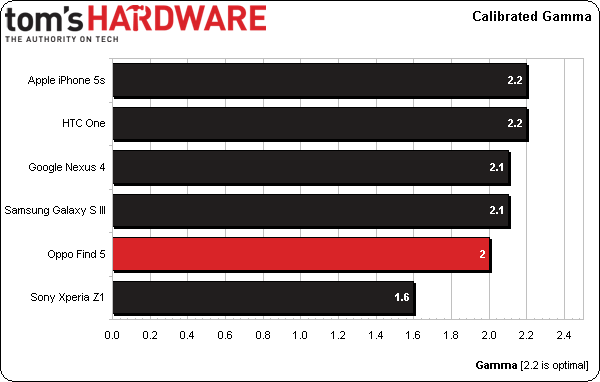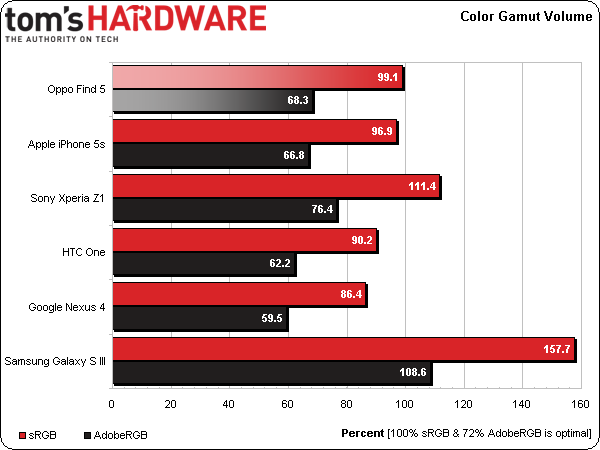Oppo Find 5 Review: A Phone Of Firsts From A Brand To Watch
Has a relatively unknown Chinese manufacturer of high-end home theater equipment actually created a flagship Android smartphone capable of going head to head with the industry's established heavyweights? We take Oppo's S4 Pro-powered Find 5 for a spin.
Results: Display Measurements
With the obvious exception of our minimum and maximum brightness tests, all display measurements are done with device’s screen set to a standardized brightness level of 200 nits to allow for a meaningful comparison to take place.
Display Brightness
The display's luminance output is recorded using a full white pattern with the software slider set at its maximum and minimum values.
Although the Find 5's maximum brightness of 380 nits is middling compared to the iPhone 5s, the screen is still usable outdoors and even in direct sunlight.
Black Level
The calibrated black level test measures the luminance ouput of a full black pattern when full white has been standardized to 200 nits. It is important to note that this test is impossible to perform on AMOLED displays (like the Galaxy S3) since the pixels simply turn off to render black.
The Find 5 scores 0.3 nits in this test and comes in joint second with the iPhone 5s. The Xperia Z1 unsurprisingly falls far behind since its minimum brightness of 31.3 nits is 10 and 7 times higher than the Find 5 and iPhone 5s respectively.
Contrast Ratio
Next, we move on to contrast ratio, which measures a white pattern versus a black pattern. As with the calibrated black level test, no data can be presented for the Samsung Galaxy S3 since it features an AMOLED display.
The HTC One's SuperLCD3 display scores a convincing victory here with the Find 5 and Xperia Z1 finishing at the bottom due to the former's relatively low maximum brightness and the latter's relatively high minimum brightness.
Get Tom's Hardware's best news and in-depth reviews, straight to your inbox.
Color Temperature
Color temperature is a measurement in Kelvin which is used to describe how “warm” a given display is. These are colors derived from the CCT or correlated color temperature. All of the displays tested are in the cool range (basically any temperature above 4000 Kelvin), but the following chart should give some indication of how they tend toward one end or another of the CCT scale.
The Find 5 along with the Google Nexus 4 and Galaxy S3 all reside in the upper end of the CCT categorization for LCD / CRT screens with whites being displayed with a cool blue hue. By comparison the Xperia Z1's color temperature of 7000 K is much closer to a properly-calibrated desktop display.
Gamma
A gamma curve of 2.2 is what we optimally want to see.
The Find 5 scores an acceptable 2.0 gamma level with the iPhone 5s and HTC One finishing first with optimal gamma ratings.
Color Gamut
Our volume measurements are compared against both the sRGB and AdobeRGB color gamuts. A reading of 100% on sRGB and 72% on AdobeRGB is the optimal reading for viewing the vast majority of consumer digital content.
The Find 5's display really shines in this test with the ability to reproduce 99.1 percent of sRGB and 68.3 per cent of AdobeRGB, scores that even edge out Apple's Retina Display.
Overall, the quantitative testing confirms the observations made earlier in the review; the Sharp IPS LCD screen included on the Find 5 is fully capable of competing with other high-end smartphones. Its relatively weak performance in luminance may not be that significant since the phone is still quite readable outdoors, and indoors it’s a non-issue, as most users generally don't operate their smartphones at maximum brightness in order to preserve battery life.
Current page: Results: Display Measurements
Prev Page Results: Web Tests Next Page Benchmark Results: Battery Life TestsTarun Iyer was a contributor for Tom's Hardware who wrote news covering a wide range of technology topics, including processors, graphics cards, cooling systems, and computer peripherals. He also covered tech trends such as the development of adaptive all-in-one PCs.
-
Mr Fender Hey guys, you forgot about their ColorOS - now it's basically the official firmware of OPPO Find5.Reply -
marclee37 I live in Hong Kong ssp, I see there are much many other China brand good looking good quality Android phones- 2gb ram is a norm, 3gb ram started to appear. 1080 screen, 5" screen, 13M cam, these are basic general spec, for price no more than US$320.Reply -
house70 Being unlocked, it is a perfect go-to phone for trips abroad. As far as hardware, the only "downside" is the lack of LTE bands in it's radio.Reply
SOftware is where it lacks, though. I got this because Oppo promised frequent updates to the OS, and TBH the Android-based variant it came with was not too bad of an experience. Then it became clear that the development team does not really know what they're doing (same minor but annoying bugs with every release, now barely coming through with 4.2, etc). They could have given CyanogenMod the kernel and drivers and let them pick up the development. CM-based ROMs are functional, but still plagued by bugs that come from lack of access to proprietary code.
Basically, their approach (at one point there were 2 or 3 versions of ROMs in development, none out of a beta state) stretched them way too thin, and it shows.
Last but not least, ignoring many requests of just embracing AOSP and let the plethora of apps do the rest was not a smart move on Oppo's part. -
danlw As an Audioholic, I have heard of the Oppo name. Their Blu-Ray players are considered by many in the high-end community to be top quality. In fact, Lexicon, a maker of ultra-elite electronics, actually stuck a $500 Oppo BDP-83 inside a new case and sold it for $3,500! (Audioholics: Lexicon BD-30 Blu-Ray Player (Oppo BDP-83 Clone) Review)Reply
With this phone, however, I doubt Apple will stick it inside their own chassis and call it ther own. It is mildly interesting, but as is often the case, forays into new market segments by otherwise high quality manufacturers are often precarious.
By all means, get an Oppo Blu-Ray player. As far as the phone, they need to get through their growing pains. -
programit Why isn't the phone compared to current versions of others. I see you put it against the latest iphone and a 16 month old dates Samsung S3. Why not the S4 or Note3 which are current models and hence what it is up against.Reply
It seemed a bit biased and not truly giving a comparison with current market phones. -
nebun got to love the iPhone 5s....like it or not....it's the best all around...the benches speak for themselves...did it mention "NO CRAPWARE and FAST OS UPDATES"Reply
